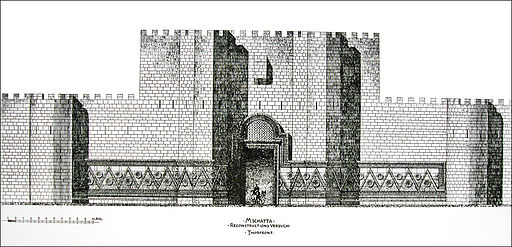
The Mshatta Facade is the decorated part of the façade of the 8th century, Umayyad residential palace of Qasr Mshatta, which was one of the Desert Castles of Jordan.
The Mshatta Facade is a monument of early Islamic art and architecture, demonstrating early forms of the arabesque, millefleur, and animals carved in relief.
The decoration on the left side of the facade shows many animals among the foliar forms. On the right of the entranceway in the center, there are no animals.
The carved stone wall, in the Pergamon Museum, is only a small section of the full length of the facade, surrounding the main entrance.
Most of the palace wall was undecorated and remained in its original place in Jordan. The facade belonged to the Mshatta palace, which was excavated about 30 km south of the Jordanian capital of Amman.
It served as a winter residence during the Umayyad period. The building dates to 743 and unusual for the time, the main structures are built from burnt bricks resting on a foundation layer of finely dressed stone and carved stone.

Drawing of the reconstruction by in 1903
The name of the place, Mshatta, is a name used by the modern Bedouins in the area, and the original name remains unknown. The remains of the palace were excavated in 1840.
The facade was a gift from the Ottoman Sultan to Emperor of Germany. A large part of it was brought to the then Kaiser-Friedrich-Museum, now the Bode Museum in Berlin in 1903.
It was reconstructed as a 33 meters long, 5 meters high facade, with two towers, and parts of a central gateway. In 1932 it was moved and restored in the Pergamon Museum.
Unfortunately, it was severely damaged during the Second World War during the bombardment of Berlin.

Arabesque
Arabesque is a form of artistic decoration consisting of rhythmic linear patterns of scrolling and interlacing foliage, tendrils, or plain lines, often combined with other elements.
Foliate ornament typically uses leaves, derived from stylized half-palmettes, which were combined with spiraling stems. This art form usually consists of a single design that can be repeated as many times.
The term “arabesque” is used by art historians to describe elements of the decoration found in Islamic art from about the 9th century onwards and European decorative art from the Renaissance onwards.
Qasr Mshatta
Qasr Mshatta is the ruin of an Umayyad winter palace, commissioned by Caliph Al-Walid II during his brief reign (743-744). After Al Walid was murdered, it was left incomplete and later ruined in an earthquake.
The sections of the outer wall remaining in its original place are much duller. The ruins are located about 30 km south of Amman, Jordan, and are part of a string of castles, palaces, and caravanserais known collectively in Jordan as the Desert Castles.
The ruins of Qasr Mushatta consist of a square enclosure, surrounded by an outer wall comprising 25 towers.
There are many castles and palaces in Syria and Jordan that date from the Umayyad dynasty, the so-called “Desert Castles.” Qasr Al-Mshatta is one of the grander examples.
They seem to have had many roles, probably including political and military control of the local area, and for entertainment and hunting.
Desert Place of Mshatta Facade – 360 Virtual Views
Umayyad Caliphate
The Umayyad Caliphate was the second of the four significant caliphates established after the death of Muhammad.
The Umayyad dynasty ruled the caliphate, and Damascus was their capital. During the period of the Umayyads, Arabic became the administrative language.
State documents and currency were issued in the Arabic language. Mass conversions brought a massive influx of Muslims to the caliphate.
The Umayyads also constructed famous buildings such as the Dome of the Rock at Jerusalem and the Umayyad Mosque at Damascus.
Umayyad Desert Castles
The Umayyad desert castles, of which the desert castles of Jordan represent a prominent part, are fortified palaces or castles.
Most Umayyad “desert castles” are scattered over the semi-arid regions of north-eastern Jordan, with several more in Syria, Israel, and the West Bank (Palestine).
The castles represent some of the most impressive examples of early Islamic art and Islamic architecture.
Some of the castle decorations are notable for including many figurative frescos and reliefs depicting people and animals, less often found in later Islamic art on such a large and public scale.
Many elements of the desert palaces are on display in museums in Amman, in Jerusalem’s Rockefeller Museum (decorations from Hisham’s Palace) and the Pergamon Museum of Berlin (the Mshatta Facade).
The Desert Place of Mshatta Facade
- Name: The Desert Place of Mshatta Facade
- Created 743
- Origins: Amman, Jordan
- Discovered: 1840
- Culture: Umayyad
- Material: Stone
- Dimensions: 5 meters high facade
- Category: Islamic Art
- Museum: Pergamon Museum
Explore the Pergamon Museum
- The Pergamon Altar
- Ishtar Gate
- The Market Gate of Miletus
- Tile – Building Ceramic – Iran 13th – 14th Century
- Lion Hunting Scene – 750 BC
- Islamic Astrolabe
- Islamic Prayer Niche
- Victory Stele of Esarhaddon
- Desert Place of Mshatta Facade
- Temple of Ashur Water Basin
- Masterpieces of The Pergamon Museum
Jordan, Umayyad Qasr Mshatta – Desert Castle
Mshatta Facade, Pergamon Museum, Berlin, Germany
Arabic Proverbs, Quotes, and Sayings
- Arabic Proverbs, Quotes, and Sayings
The Desert Castles of the Omaijades
The Desert Place of Mshatta Facade
~~~
“That men do not learn very much from the lessons of history
is the most important of all the lessons that history has to teach.”
– Aldous Huxley
~~~
Photo Credit: 1) JOM Sources: Museum material and Wikipedia
Popular this Week








 Sponsor your Favorite Page
Sponsor your Favorite Page SEARCH Search for: Search Follow UsJoin – The JOM Membership Program
Sponsor a Masterpiece with YOUR NAME CHOICE for $5
Share this:
- Tweet
